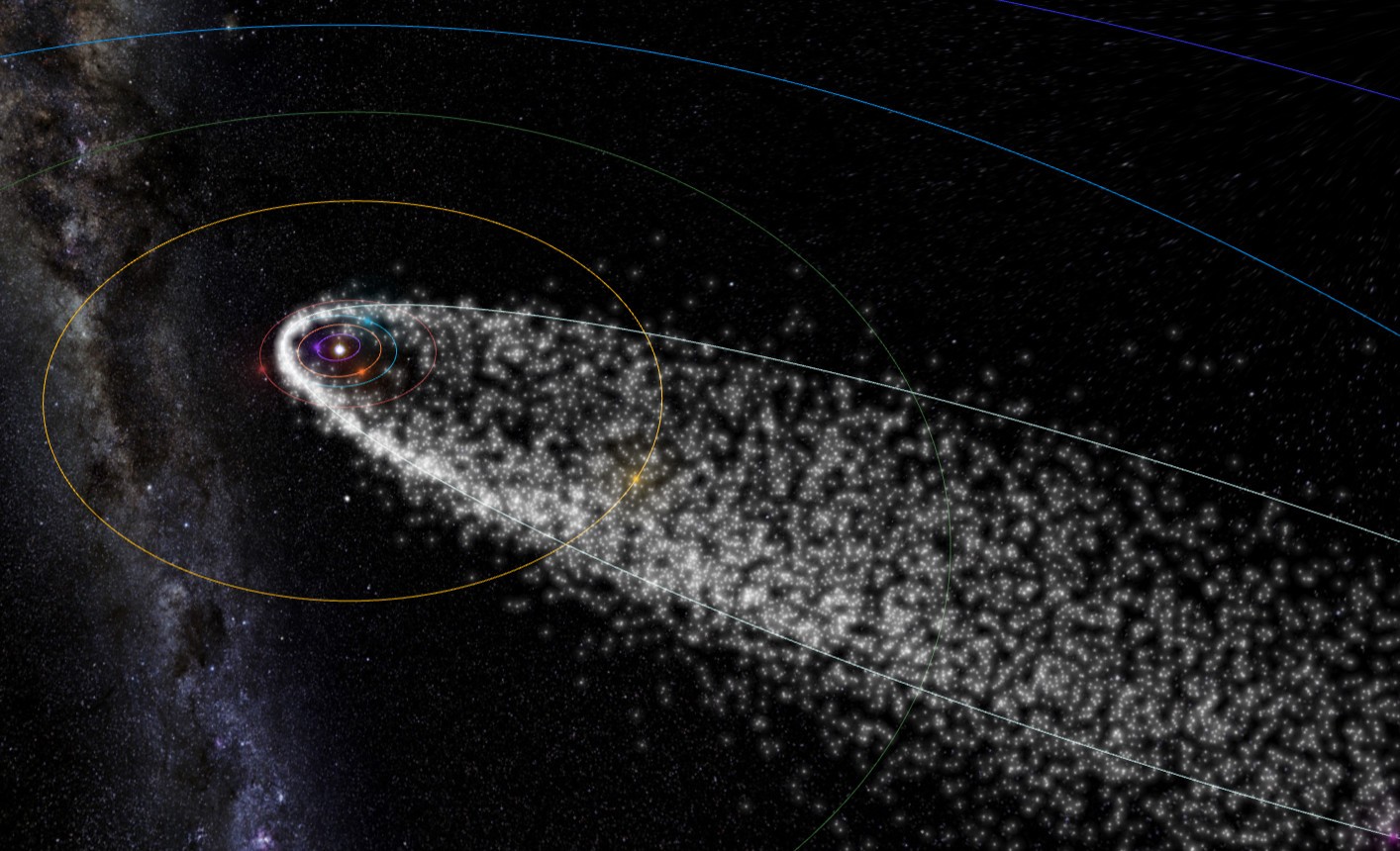据《天体物理学杂志》7日发表的一项研究,包括美国哈佛—史密森尼天体物理中心研究人员在内的一个国际天文学家团队发现了有史以来最遥远的星系。这个名为HD1的候选星系距离我们约135亿光年。
研究团队提出了两个想法:HD1可能正在以惊人的速度形成恒星,甚至可能是宇宙第一颗恒星Population Ⅲ恒星的家园,或者,HD1可能包含一个超大质量黑洞,其质量约为太阳质量的1亿倍。
论文合著者、天体物理学中心天文学家法比奥·帕库奇说:“回答有关如此遥远星系性质的问题可能具有挑战性。这就像一艘船在遥远的岸边,在大风和浓雾中,从它所悬挂的旗帜中猜测它的国籍。人们可能会看到旗帜的一些颜色和形状,但不是全部。归根结底,这是一场分析和排除不合理场景的漫长游戏。”
An international team of astronomers, including researchers at the Harvard-Smithsonian Center for Astrophysics, has discovered the most distant galaxy ever discovered, according to a study published in The Astrophysical Journal on the 7th. The candidate galaxy, named HD1, is about 13.5 billion light-years away.
The research team has come up with two ideas: HD1 may be forming stars at an alarming rate and may even be home to the universe's first star, Population III, or, HD1 may contain a supermassive black hole with a mass of about 1 solar mass. billion times.
"Answering questions about the nature of such distant galaxies can be challenging," said paper co-author Fabio Pacucci, an astronomer at the Center for Astrophysics. "It's like a ship on a distant shore, in high winds and thick fog. , guess its nationality from the flag it flies. People may see some colors and shapes of the flag, but not all. At the end of the day, it's a long game of analysing and ruling out unreasonable scenarios."
HD1 is very bright under UV light. At first the researchers assumed it was a standard starburst galaxy, one that is creating stars at high speed. But after calculating how many stars HD1 produced, they found that HD1 was forming more than 100 stars a year. The speed was unbelievable, at least 10 times higher than they expected.
The team began to suspect that HD1 might not form the usual stars. "The first stars that formed in the universe were bigger, brighter, and hotter than modern stars," Pakucci said. "If the stars produced in HD1 were these first or third population stars, then its properties would be easier. Explanation. The fact that Group III stars produce more ultraviolet light than ordinary stars sheds light on the extreme ultraviolet luminosity of HD1."
However, supermassive black holes could also explain HD1's extreme brightness. The region around the black hole may emit high-energy photons as it devours a large amount of gas.
If so, it would be the earliest known supermassive black hole to date, observed closer to the Big Bang than the current record holder.
"HD1 will represent a giant baby in the birthing room of the early universe," said Ivy Loeb, an astronomer at the Center for Astrophysics. "Its redshift is almost twice the redshift of the highest quasar ever recorded, which is a A remarkable feat."
"Finding HD1 from more than 700,000 celestial objects is a very tough job," said the team's researchers. "HD1's red color matches well with the expected features of galaxies 13.5 billion light-years away."
The research team performed follow-up observations using the Atacama Large Millimeter/submillimeter Array (ALMA) to confirm the distance, which is 100 million light-years further than the current record holder for the most distant galaxy, GN-z11.
They will also observe HD1 again using the James Webb Space Telescope to verify its distance from Earth. If the current calculations prove correct, HD1 would be the most distant and oldest galaxy on record.
These observations will allow the research team to dig deeper into the "identity" of HD1. "Formed hundreds of millions of years after the Big Bang, the black hole in HD1 must have grown at an unprecedented rate from a huge seed." Loeb said, nature seems to be more imaginative than us.
HD1在紫外光下非常亮。起初研究人员假设其是一个标准的星暴星系,也就是一个正在高速创造恒星的星系。但在计算了HD1产生了多少颗恒星之后,他们发现HD1每年会形成100多颗恒星。这一速度简直令人难以置信,至少比他们的预期高出10倍。
团队开始怀疑HD1可能不会形成通常的恒星。“宇宙中形成的第一批恒星比现代恒星更大、更明亮、更热。”帕库奇说,“如果HD1中产生的恒星是这些第一或第三族恒星,那么它的性质更容易解释。事实上,第三族恒星能产生比普通恒星更多的紫外线,这可阐明HD1的极紫外光度。”
然而,超大质量黑洞也可以解释HD1的极端亮度。当它吞噬大量气体时,黑洞周围的区域可能会发射出高能光子。
如果是这样的话,这将是迄今为止人类已知的最早的超大质量黑洞,与目前的纪录保持者相比,观测到的时间更接近宇宙大爆炸。
“HD1将代表早期宇宙产房中的一个巨大婴儿。”天体物理中心的天文学家艾维·勒布说,“它的红移是有记录以来最高的类星体红移的几乎两倍,这是一项了不起的壮举。”
“从超过70万个天体中找到HD1是一项非常艰巨的工作。”团队研究人员表示,“HD1的红色与135亿光年外星系的预期特征非常吻合。”
研究团队使用阿塔卡马大型毫米/亚毫米阵列(ALMA)进行了后续观测以确认距离,该距离比目前最远星系的纪录保持者GN-z11还要远1亿光年。
他们还将使用詹姆斯·韦布空间望远镜再次观察HD1,以验证它与地球的距离。如果目前的计算证明是正确的,HD1将是有记录以来最遥远、最古老的星系。
这些观察将使研究团队能够更深入地挖掘HD1的“身份”。“在大爆炸后数亿年形成,HD1中的黑洞一定是从一颗巨大的种子中以前所未有的速度生长出来的。”勒布说,大自然似乎比我们更有想象力。
